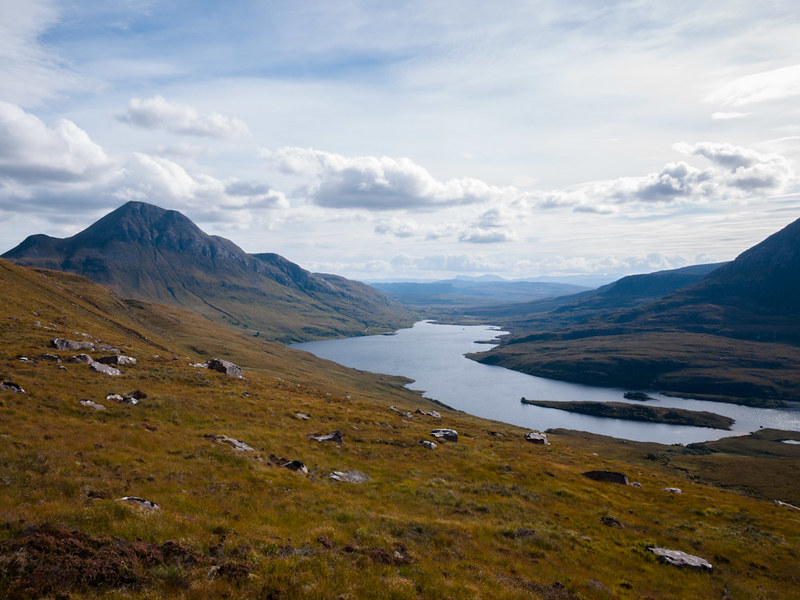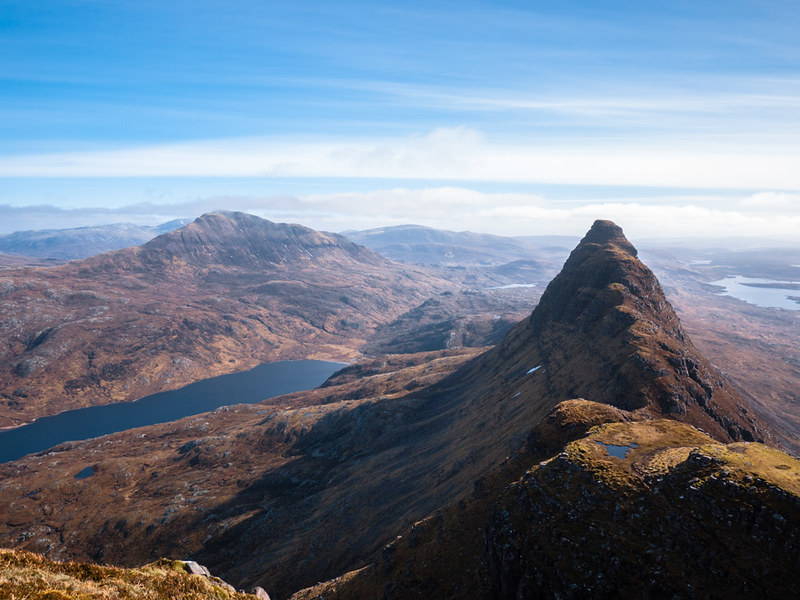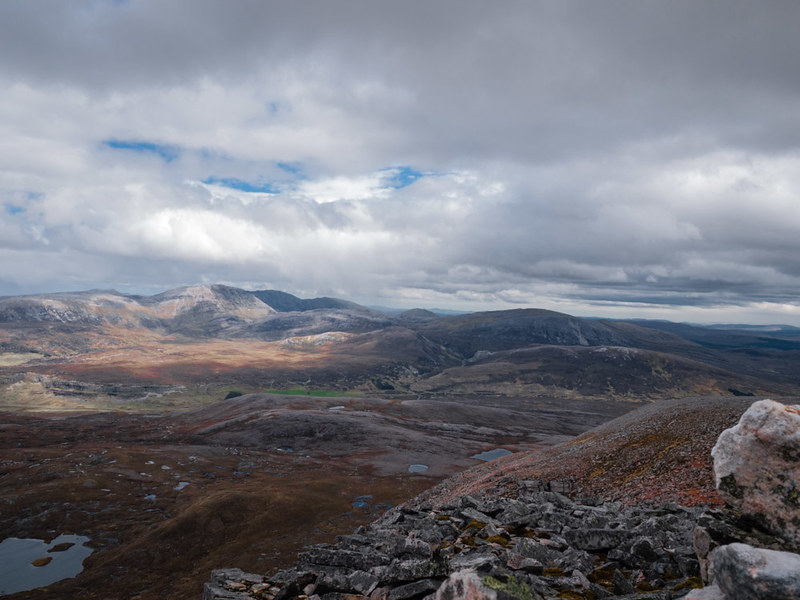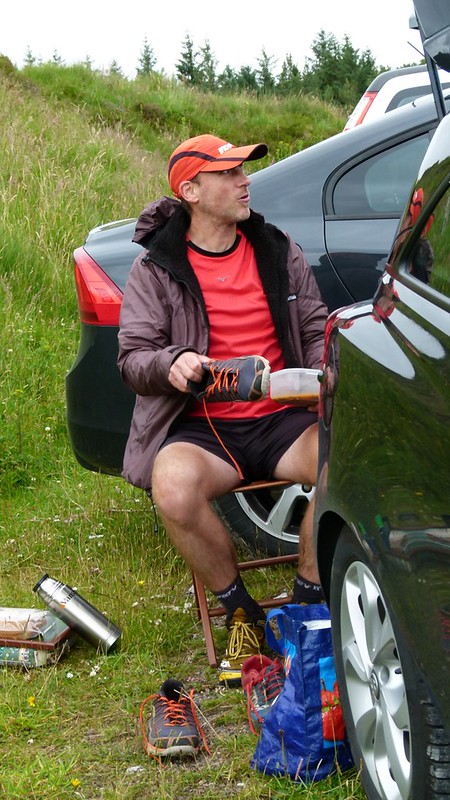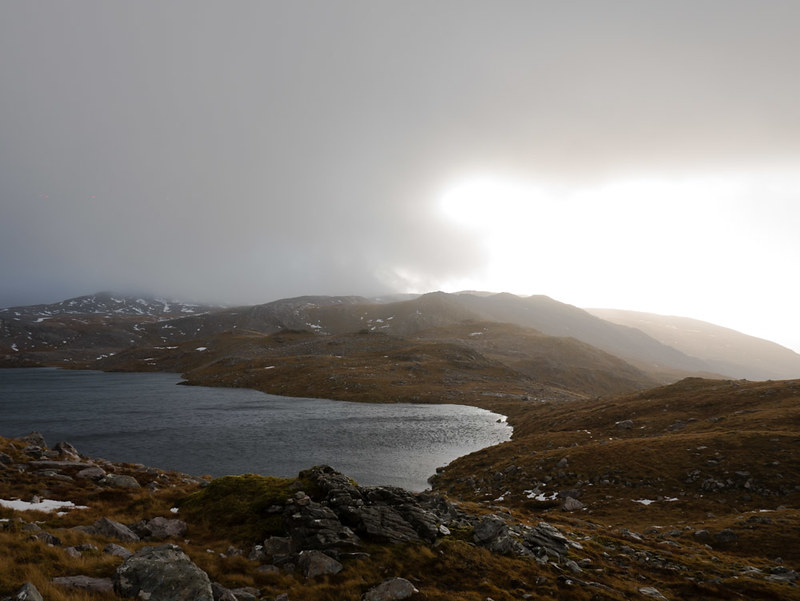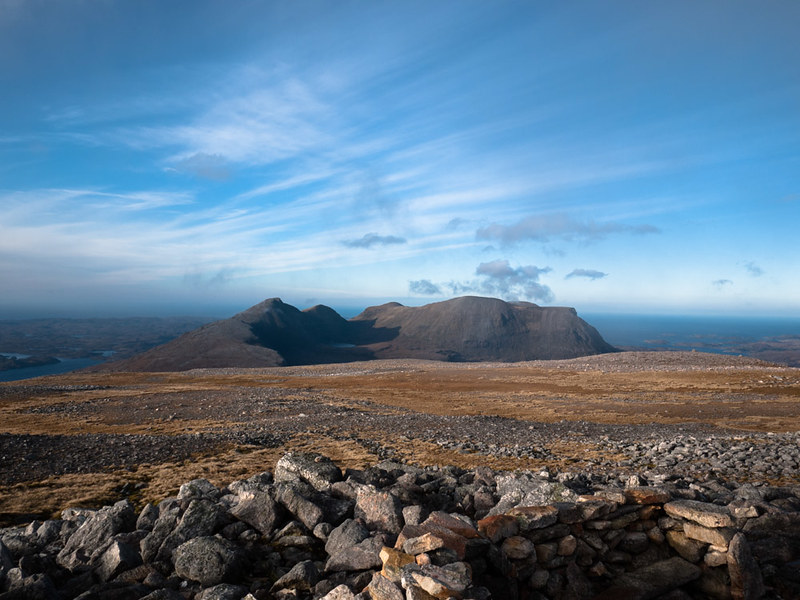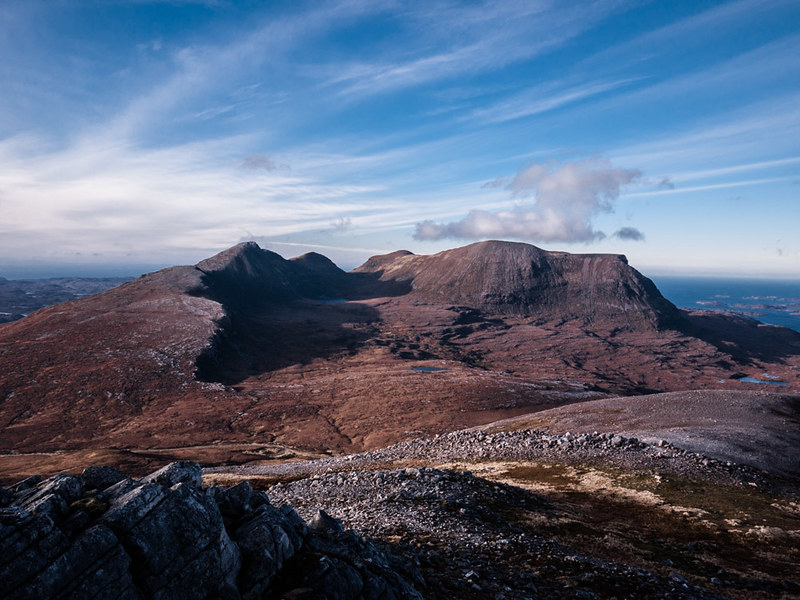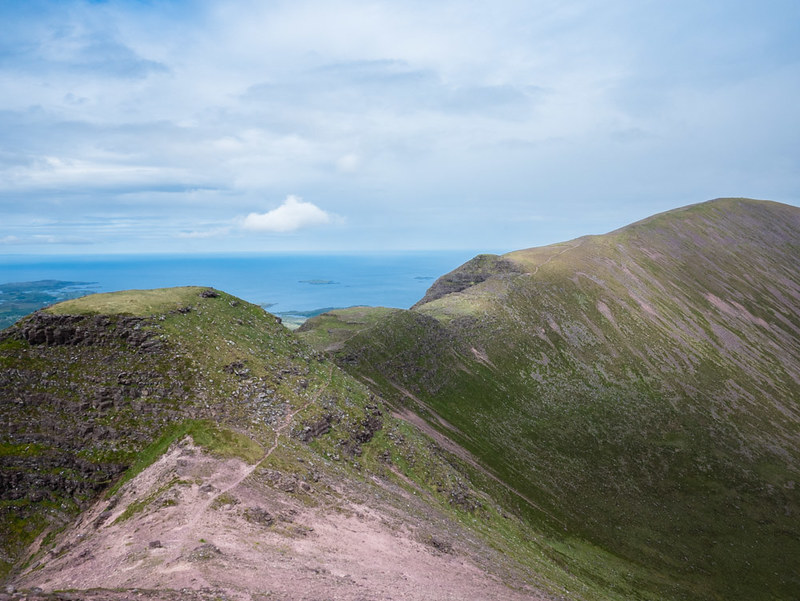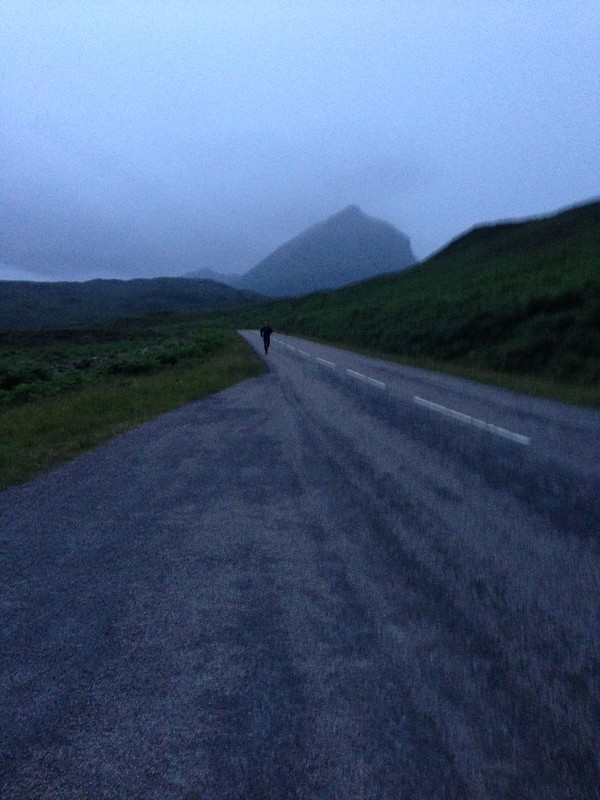It's 2:55am and the day, which is supposed to be a culmination of a three year long dream, is being (un)ceremonially drummed in by rain on a skylight window in Inchnadamph Lodge Hostel.
Over the last couple of weeks I have dithered much over this 'alpine' start. I expect to be on my feet for over 24 hours and the lack of good night's sleep doesn't seem conducive to success. But the middle leg of the Assynt Traverse is over difficult technical ground, and there is lot to be said for covering as much of it as possible in daylight. This consideration (together with Linda, my long suffering wife, pointing out I am unlikely to sleep well anyway), wins the argument. This time of the year there are around 18 hours of daylight -- almost, but not entirely, enough for the first two legs on an overall 24 hour schedule. Hence a sunrise (4:34am) start.
Lot of planning and careful preparation has preceded this morning, but the date, 14 July 2016, is a complete gamble. That wasn't the plan. The plan was to run the twelve peak traverse a month earlier during our two week holiday up here. It was the perfect plan. The weather was exceptionally good. Two weeks of blue sky and sunshine on the back of an already prolonged dry spell. The peat bogs were bone dry. Instead of returning from our runs caked in mud as usual, we were covered in dust stuck to suntan lotion. But I wasn't ready.
It wasn't because of not training hard enough. After summarily failing to reach the requisite fitness in 2014, and again in 2015, I finally did the unthinkable and adopted an eight month training plan. But the weather in January and February meant I was stuck doing hill reps on a road, and you can't get ready for Assynt on a road. Of the 74km or so, at least 60 is not just off road, but off track. Plus they don't make roads steep enough anyway (mine is 25%, in Assynt terms, a pleasant uphill jog). But the training plan had, nevertheless, paid off. Unlike in the previous years, come June it is beginning to come together nicely, it's just that I am a month behind the schedule, and the attempt has to wait.
Of course, Linda and I can't afford to come back for another two week stay just a month later. Linda, who is my support team without whom this can't happen, can perhaps get a couple of days off work -- this has to be a precision operation. And naturally, the weather has turned in late June. From early July I follow the forecast anxiously, hoping for a 'window', but it is consistently awful; heavy rain and high winds. There is also the fact that I need a period of taper, but too long a taper and I will start losing fitness. And there is the approaching deer stalking season, which closes the window of opportunity for the year -- I am running out of time.
And then last Saturday the forecast suggests there will be a window this Thursday; it is not perfect, light rain is expected till 6am or so, and then more rain on Friday, but it is not going to be too windy. And so here we are, five days later, at first light in Stac Pollaidh car park. The forecast has changed a bit since. The morning rain is not so light, and the front coming on Friday is quite a bad one, but there is still supposed to be a wind-free window in between. And just now there is a pause in the rain, enough for a 'before' picture. We are a few minutes early, but there is no point hanging around -- 4:26 seems as a good time to start as any.
With the exception of the safety-critical descent from Cul Mor, the first leg (Stac Pollaidh, Cul Beag, Cul Mor, Suilven and Canisp) is best described as straight forward but absolutely brutal -- the climbs and descents are very steep, and the 'easy' ground in between is bog and knee high grass. Stac Pollaidh is the easiest bit there will be, and just now on fresh legs I have to apply a lot of self control to conserve energy and not run.
I take the classic route reaching the western summit at 5:06, 20 minutes ahead of schedule. For a fleeting moment the thought that this might be lot easier than expected enters my mind, but I promptly banish it -- I have spent three years exploring the route, and know what lies ahead. My mind is spared further idle thoughts by a torrential shower that soaks me to the skin in seconds. The showers will keep coming for the next four or five hours, but fortunately none again as heavy.
I take it easy on the next segment. Too easy as it turns out; 6:27 on the summit of Cul Beag means I am 4 minutes off pace for this segment. Having investigated the direct descent via the north east coire previously, and found it unexpectedly unpleasant, I head back down the way I came and pick up the stalker's path through Doire Dubh, which allows for a good pace and minimal effort.

But climbing Cul Mor, things are not going well. My legs are hurting badly, and in spite of my best efforts I am moving very slowly. I am only a bit over three hours into this outing and this should not be happening -- I have serious doubts about being able to finish the first leg, never mind the whole run. I summit 7 minutes behind schedule at 8:36, which means I have lost 23 minutes on this segment. Cloud base is down to 600m, visibility about five yards.
The descent from Cul Mor is the most safety-critical point on the route. The north face is made of vertical cliffs scarred by narrow bottomless gullies which the OS map doesn't do credit to. The only safe descent to my knowledge can be initiated around the NE edge of Coire Gorm, but locating the exit point in low visibility is tricky, as a number of the bottomless gullies have inviting grassy openings looking just like it but leading to oblivion. I am glad I have recced this descent thoroughly, but even then this not just another hill run.
Safely descending the upper mountain is only the first part of the challenge. The lower section of Cul Mor is made up of terraces separated by 10-15m vertical sandstone cliffs, difficult to find a way through even when heading up. The easiest way down the first terrace is a hundred yards or so east of the stream that flows out of the coire, the rest can then be descended near the stream.
I am glad to be out of the clouds now. The views are beautiful, all the lochs around here have reddish sandy beaches, and I stop on the one at the head of Loch na Claise for a quick bite to eat, before heading down to the sandbar that separates Loch a' Mhadail from Loch Veyatie. Someone built a cairn here from a couple of shoebox sized blocks of quartzite -- very minimalist, very arty. I can't resist the temptation to haul another block on the top. It's very wobbly, and, like my footprints in the sand, it will be gone as soon as the wind picks up tomorrow -- in this aeons old landscape it is impossible to be unaware of one's own transience.
Another heavy shower, then the wading of Uidh Fhearna. In spite of the recent rain, it is only knee deep, though the current is lot stronger than usual. The sun comes out and I am moving well, the earlier crisis but a distant memory -- I am making up the lost time. Then on the steep path up to Suilven's Bealach Mor I start getting a sharp pain in my right knee. This is new, I have never before experienced knee pain going uphill, nor a knee pain this intense. But as the ground eases off at the bealach the pain fades away.
I am at the summit cairn at 11:17, a whole 9 minutes ahead of my schedule. As I descend, I meet a few walkers not far above the Glen Canisp landy track; they are the first people I have run into, and as it happens they will be the last people I will meet on the open hill until I finish. This suits me fine; this is about me and my hills.
Canisp is my favourite Assynt hill. It lacks the ostentatiousness of Suilven, its drama queen little brother, but its western ridge is very runnable (not that I am running just now), and it is rainbow like -- the gneiss at the bottom is replaced by a band of pink/orange pipe stone, which in turn is replaced by dark red Torridonian sandstone, while the summit is topped by blocky grey and white quartzite. I seem to run out of energy just below that last band, have a gel on the summit (13:13, 11 minutes ahead of schedule), then head down. Weather is improving and I can see the Bone Caves car park where I am supposed to meet Linda.
The Canisp descent is one of the few bits of this run I couldn't be bothered to investigate; there seemed no need, there is a path down to the road, then a bit on the road. In a moment of poetic justice for this blazé attitude I somehow manage to pick up the wrong path on the summit, which peters out soon enough, but too late to go back. I make most of the stunning landscape. The quartzite here is pure white, contrasting sharply with the green grass. Not more than twenty yards away a golden eagle rises off the ground, and flaps lazily to settle down just a little bit farther on. I imagine it feels like I felt when bumping into the walkers on Suilven -- 'Is there nowhere one can have some me-time'?
Further down a fox is sniffing around. Foxes are not that common around here, and this one is not like the urban foxes of Glasgow either. Its fur is fluffy and shiny. It doesn't see me coming, so I give it a courteous whistle, nobody likes to get a fright. I am assessing my physical condition. I am tired, my quads are very tight and sore. I am certain now I don't have it in me to pull this off. But I am not spent yet, and on the next leg there are four points I can bail out descending directly to the Inchnadamph Lodge where we are staying. I make the decision to carry on, for I need to find out how far I can manage so I am better prepared next year. I hit the road a couple of hundred yards south of the carpark just as Gita and David are driving from the other direction. I am 2 minutes ahead of schedule.
Gita and David are Inverkirkaig crofters. We first stayed with them in their bespoke Lazybed Cabin almost four years ago, and have done so ever since. They are also both ultra runners; they understand. During our stay in June David successfully completed the South Downs Way 100 miler and talking to him afterwards about the experience brought some badly needed clarity into my own thinking. I expect they don't fully appreciate the importance of their being here at this moment, both for me and Linda, but their infectious enthusiasm raises the mood at the pit stop.
As is typical of Assynt these days, the small carpark is hogged by the camper van menace, but Linda has decisively made most of the little space there was to be found. I have a pint of full-fat milk (my secret weapon), some home made black eye bean and bacon soup with a bit of bread, a chunk of ginger bread and sweet coffee. After 10 hours of sodden feet it is nice to put on dry socks and a dry pair of Inov-8 TrailRock shoes, while Linda's already stuffing newspapers into the soaked Mudclaws. I try to loosen the quads with a foam roller, but it's not working and my 30 minutes are up.
The stop has made much more difference than I would have thought and I jog comfortably past the Bone Caves. The second leg of this run has a more amenable profile, the 20km or so long ridge forming an aesthetically pleasing line. The price for this is much more technical ground, the whole ridge is essentially just a one long heap of stones (hence the TrailRocks rather than Mudclaws). Navigation on the Breabag section in particular is difficult in poor visibility, and the quartzite becomes lethal when wet -- this has been weighing on my mind since the morning rain. But it is a beautiful afternoon, blue sky, sunshine, and no wind to speak of.
From afar Braebag appears to be an impenetrable, intimidating, wall of shiny quartzite. As I am approaching it, I start feeling a twinge in my right hamstring -- I have been expecting it, I have always been very cramp prone, the only surprise is it took so long; I have got some salt tablets. Except during the pit stop I made the mistake of just replenishing my supplies rather than simply swapping out the ready made bags for each leg; in doing so I managed to leave both the tablets for the previous leg and this leg behind. Then I remember there should be four tablets in my minimalist emergency kit; I always carry these, and never use them ... I chew one hoping the salty taste will fool my brain, in the knowledge this is probably no more than a placebo. But it works.
On the way up Breabag there are some lovely pitted quartzite slabs to negotiate. In my climbing days I used to have a thing for slabs, and so make most of it. The knowledge I am not going to finish the Traverse this time round has taken some of the pressure off, and this is real fun. I reach the summit at 16:15, 9 minutes ahead of schedule. On the previous occasions I have been up here it was either clagged out or damp. But today running Breabag is pure pleasure. The dry quartzite is grippy, the blocks are generally firmly locked together, rarely moving under my feet, and I am able to link up numerous rising slabs together into satisfying lines. The views are stunning in all directions -- it has been a while since I enjoyed a run this much (this is why I hate training schedules, they make running about something other than the fun).
I descend into the narrow bealach below Conival along the east ridge of Breabag Tarsainn. Above the bealach the ridge changes from quartzite to limestone, and I pass two small water holes, each no more than four or five feet across, full of tadpoles and black as night. The water itself is crystal clear, I imagine that under my feet there is likely to be a deep cavern filled with water -- I make a note to come back one day with a string to plumb it out.
On my previous visits I have concluded that the fastest, as well as most pleasing, way up Conival is to scramble up its SSE ridge. The scramble is not particularly difficult, but there is no obvious line lower down, so one has to be prepared to head 'into the unknown', while the upper section is quite exposed. I review this briefly in the light of being on my feet for 14 hours, and carry on. I am not moving very fast. The pain in my right knee returns, and then, perhaps because I am overcompensating, I feel a few twitches in my left calf. I chew on another salt tablet, and again, it seems to do the trick.
I summit at 18:39, a whopping 26 minutes ahead of schedule, have a bite to eat, and then, as I am setting off for Ben More, I realise I made a mistake in my schedule calculations -- I had only allowed myself 11 minutes to get to Ben More. I have done this on much fresher legs before and it took me 20 minutes. I feel scunnered and angry with myself for not noticing it at home, but there is nothing for it; it takes me 25 minutes. But then as I am running back to Conival I suddenly realise that there is no pain in my legs, those sore quads and twitching hamstrings and calves, it's all gone. I am not moving very fast, but I am moving very comfortably. And it is at this point, 15 hours into the run, all thoughts of quitting are gone. I know with absolute, irrational, certainty that I am going to finish; suddenly another 9 hours feel like just another long run.
By the time I am back on Conival I am 7 minutes behind schedule. It's time to pull my finger out and start running. I am struck by how crystal clear the water in the unnamed lochan just below the Beinn an Fhurain bealach is, then up the little rise into the bealach. I recced the section between here and Loch nan Cuaran in April when there was still a fair bit of snow, and got the impression it is going to be a proper bog fest. I am in for a pleasant surprise. Sure, the ground here is completely waterlogged (and for inexplicable reasons the water is ice cold), but the surface is covered in short grass, and is most pleasant to run on. And so I run, surrounded by deer on all sides. Down below me are remnants of a WWII RAF aircraft, and the story of the six airmen buried somewhere here below my feet plays out vividly in my imagination.
At the north west end of Loch nan Cuaran I pick up the ancient pony track, which is not on maps, but which I stumbled on a few years back on what has become my favourite Assynt run; today it just provides an easy way onto the Beinn Uidhe ridge. This is another part of the run I did not bother to recce. The line here is obvious, and equally obviously unpleasant. It is amazing how the nature of the 'heap of stones' changes along this long ridge -- on Breabag, the blocks tend to be quite large and firmly interlocked, on Conival and Ben More they are smaller and looser, making metallic clanking sounds, requiring more care, but still fun to run; on Beinn Uidhe, the stones are smaller, more round, and invariably moving about! I pick my way carefully, twice nearly falling when a large block that should not be able to move does. I arrive at Glas Beinn at sunset at 22:11, 25min ahead of schedule.
I manage most of the descent without a head torch, but I am not doing that well going down; I lose 11 minutes by the time I reach the second pit stop car park below Quinag, where Linda is waiting for me, at 23:05. I have some milk, a big chunk of ginger bread, a banana and some coffee. I put on extra clothes, dry socks and the Mudclaws (which Linda somehow managed to get nearly dry!), and leave at 23:27. By now it is pitch dark, there is no light pollution here, and the sky is clouded -- the next weather front is on its way. I am 22 minutes ahead of schedule, but I am very much aware that at this stage in the game that means very little.
The third leg consists of the three Quinag tops, and then a final descent toward Unapool. The hill itself poses no technical difficulties per se, but there is some significant exposure on the descent from Spidean Coinich, the first summit. The knowledge that if it comes to it I will be tackling it in the dark, sleep deprived and at the end of an already long day has weighed heavily on my mind in the preceding weeks -- if something was to go seriously wrong on this run, this is most likely where it is going to happen. There is also the final descent, which I investigated only partially -- as will become clear shortly, this turns out to be the biggest strategic mistake of my entire 'campaign'.
The Spidean Coinich ascent is straight forward, and dry-footed. Lower down I am making most of joining together the various slabs, only to realise that I am moving too far away from the north edge of the ridge. I make a correction. For some reason, I can't get the six airmen buried on Caorach out of my head. Their story drives home not only the unforgiving nature of these hills, but also the insignificance and frivolity of my own undertaking.
As the hill steepens, the sharp pain in my right knee comes back. Also, because the head torch has a constant depth of field, it feels like I am making no progress, there is always just seventy-five metres or so to go. The wind has picked up significantly and the cloud base just touches the 764m summit. I arrive at 00:36, now only 18 minutes ahead of schedule. My original plan was to stop for a double espresso Clif Shot gel to wake me up for the descent, but I do not want hang about, and eating while moving is not an option just now.
If heading up with a head torch is frustrating, heading down is outright spooky, as if beyond the reach of the beam there was nothing there, just impenetrable black abyss. Worse though, as I start descending it is as if all proprioception disappeared from my legs, and I am relying heavily on my hands to stay upright -- this is pretty much what I was afraid of. I only manage to drop about 15m before deciding to stop and have that gel. I wait for the caffeine to kick in, which it does surprisingly quickly and with it some of my sense of balance comes back, enough to safely descend into Bealach a'Chornaidh. From here I know the rest of the mountain is straight forward.
Visibility on Sail Gharbh is not the best and there is an unwelcome wind chill. My right knee now hurts even on easy uphill inclines. I summit at 1:37, my gain has dropped to 17 minutes. As I start heading toward Sail Ghorm there is a spittle of rain, which makes me push that little bit harder, but at least now I have the wind in my back. Sail Ghorm is an easy ascent, though there is, again, that headtorch effect, and the knee is now continuously hurting. I reach the cairn at 2:32, my lead has shrunk again, I am now only 11 minutes ahead of schedule. But I just need to drop down to the road, and I have a whole hour and fifty four minutes to get it wrapped up in 'a day' -- I relax a bit.
My chosen descent is along the eastern ridge of Sail Ghorm, into the raised coire of Allt a' Bhathanaich and from there down onto the moor, then the 3km or so passing just east of Loch Airigh na Beinne onto B869 just where it 'touches' Loch Unapool, and finally a 1km jog on the road to the finish. I had done a partial descent of the eastern ridge to make sure this would work, but I had not bothered with the moor below -- it looks like a typical, complex, Assynt landscape, but neither from the OS map, nor the visual inspection from a distance is there any indication of significant difficulties.
The descent down the ridge, though rather steep, is indeed fairly uncomplicated and I am down at Allt a' Bhathanaich at around the 400m contour line by 3:08, only to discover that the stream turns into a cascading waterfall as it drops to the moor floor over a series of grassy, but nevertheless big vertical steps. There is no obvious line down. As I am scanning the ground with my head torch, trying to decide on which side of the stream I have a better chance, I spot a deer track near the edge of the terrace I am on -- it's not great, but it's something. The step below the next terrace is even bigger. I immediately start looking for a deer track, it takes me a while to find it, but it's there. In this way I negotiate a couple more steps, until I am finally on the moor. I am surprised it is only 3:29, those 21 minutes have felt like hours.
I see Loch Airigh na Beinne somewhat to my right, and it feels like getting there is going to be unpleasant. It is dawn now and I can clearly see the rise behind which is the road. I decide to make a small route change. I don't bother with the map, I have plenty of time, I am at most 20 minutes from the road, then maybe 5 minutes on the road, and I have 56 minutes to do that. I simply follow the stream until it meets the one which flows out from Loch Airigh na Beinne at its north west end, then, at leisurely pace, onto the little rise beyond which is the road.
Except, when I get there, there is no road. Instead there is a deep cut narrow glen. This is a disaster. The road must be beyond the steep rise at the other side, but I cannot face another steep climb. I can see that the glen is not very long and is shallow at its lower end -- that's where I will get out. I start ploughing through the waist deep header and grass ... and immediately fall into a hole well above my knees. I carry on and shortly I catch sight of the tarmac across the foot of the glen. I picture the map in my mind -- that's the B869 just off the junction with A894, which will be coming down the rise on my right. Indeed, I can see the tarmac ... then my brain registers, and processes the significance of, the passing place sign above me -- the A894 is a normal two lane road. I scramble onto the tarmac. I am suddenly fully awake. I am somewhere on the B869, but I have no idea how far from the main road; the fact that I am at the bottom of a hill is not a good sign at all.
It is 4:06, this is the last time I will look at the watch, there is no time to mess about with a map, there is only one thing left now ... to run. And so I run, up this hill, hoping beyond it is the junction. It is not, just more passing signs, then a bend. Surely, beyond the bend. It is not, there are more passing signs and then a loch. I keep running. Then I see headlights ... they are not very close, but neither impossibly far ... when the car does not appear, I know that's the main road. I finally reach it. I see a car park sign, and for a moment think I have arrived, then realise it's on the wrong side of the road. I see an access track, but I can't see the car park, and for the world I can't remember how far down this road it is. Finally I see Linda and the car, another couple hundred meters. I arrive, completely convinced that through sheer stupidity I missed the chance to complete the Traverse in 'a day'. I stop my watch, but dare not to look. There is lot of swearing; Linda clearly confused as to what is going on keeps saying 'you have done it'. I assume she means completing the 74km and 6,400m of ascent, but when I finally look, the watch says 23:54. I can't believe my eyes (I work out later that over the last 14 minutes I averaged 5min:23s/km while climbing over 60m; my typical road running pace these days is only about 6min/km ... I still have no idea how.)
The End
So, I have done it, though I realise that I no longer know what 'it' is. The last 24 hours have been a real journey of self-discovery. I have always expected that the Traverse was going to be a classic example of type-2 fun, and that if I ever got to finish it, it would take a long time to see it as 'fun'. I am somewhat embarrassed to admit that I found this not to be the case, and that perhaps with the exception of the last half hour, I have really enjoyed myself (and that as soon as I woke up after 3.5h of sleep on Friday, I started wondering what I am going to do next year ...).
But there is more to it than fun. I have many times before experienced moments of insight in the hills, there is something about physical exertion in the midst of peace and quiet that clears the mind, sorts out the important from the drivel. On this occasion the Caorach air crash site in particular spoke rather powerfully to me on a number of different levels; I have tried to express some of those thoughts here the day after while still fresh in my sleep-deprived mind.
I have also come to appreciate the value of companionship and friendship afresh. Those brief car park encounters were of a significance that is difficult to put into words. I'll leave it at that.
But above all, if there is one all important thing I learned from the Trans Assynt Run, it is this:
I now understand MacCaig's obsession with frogs and toads, for my eyes have seen what he saw.

